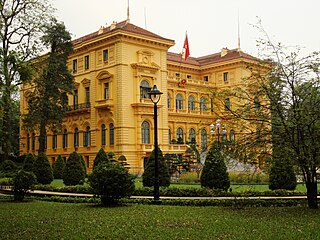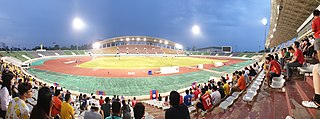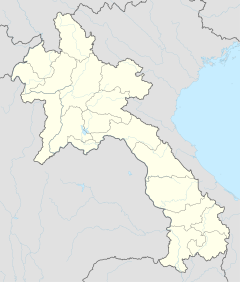
Laos, officially the Lao People's Democratic Republic, is the only landlocked country in Southeast Asia. At the heart of the Indochinese Peninsula, Laos is bordered by Myanmar and China to the northwest, Vietnam to the east, Cambodia to the southeast, and Thailand to the west and southwest. Its capital and largest city is Vientiane.

Lan Xang or Lancang was a Lao kingdom that held the area of present-day Laos from 1353 to 1707. For three and a half centuries, Lan Xang was one of the largest kingdoms in Southeast Asia. The kingdom is the basis for Laos's national historic and cultural identity.

Luang Phabang, or Louangphabang, commonly transliterated into Western languages from the pre-1975 Lao spelling ຫຼວງພຣະບາງ as Luang Prabang, literally meaning "Royal Buddha Image", is a city in north central Laos, consisting of 58 adjacent villages, of which 33 comprise the UNESCO Town of Luang Prabang World Heritage Site. It was listed in 1995 for unique and "remarkably" well preserved architectural, religious and cultural heritage, a blend of the rural and urban developments over several centuries, including the French colonial influences during the 19th and 20th centuries.

Patuxai is a war monument in Downtown Vientiane, Laos, built between 1957 and 1968. The Patuxai was dedicated to those who fought in the struggle for independence from France. In romanizing the name from the Laotian language, it is variously transliterated as Patuxai, Patuxay, Patousai and Patusai. It is also called Patuxai Arch or the Arc de Triomphe of Vientiane as it resembles the Arc de Triomphe in Paris. However, it is typically Laotian in design, decorated with mythological creatures such as the kinnari .

Pha That Luang is a gold-covered large Buddhist stupa in the centre of the city of Vientiane, Laos. Since its initial establishment, suggested to be in the 3rd century AD, the stupa has undergone several reconstructions as recently as the 1930s due to foreign invasions of the area. It is generally regarded as the most important national monument in Laos and a national symbol.
Diogo Veloso, or Diego Belloso in the Spanish historical accounts, was a Portuguese adventurer active in Southeast Asia in the last quarter of 16th century, acting sometimes in the service of the Spanish Governor of the Spanish East Indies and sometimes as a freelancer. He and Spanish Blas Ruiz were the first Europeans to ever set foot in Laos.

The 2009 Southeast Asian Games, officially known as the 25th Southeast Asian Games, was a Southeast Asian multi-sport event hosted by Vientiane, Laos. This was the first time Laos had held the Southeast Asian Games as Laos had previously declined hosting the 1965 Southeast Asian Peninsular Games, citing financial difficulties. This was also the first time the Southeast Asian Games was held in a landlocked country.

French colonial architecture includes several styles of architecture used by the French during colonization. Many former French colonies, especially those in Southeast Asia, have previously been reluctant to promote their colonial architecture as an asset for tourism; however, in recent times, the new generation of local authorities has somewhat "embraced" the architecture and has begun to advertise it. French Colonial architecture has a long history, beginning in North America in 1604 and being most active in the Western Hemisphere until the 19th century, when the French turned their attention more to Africa, Asia, and the Pacific.
The Laotian Chinese are Laotian citizens of Han Chinese ancestry. They constitute one of the many Overseas Chinese residing in Southeast Asia. At present, they constitute an estimated 1 to 2 percent of the Laotian population. The Laotian Chinese community have a disproportionately large presence in the Laotian business sector and dominate the Laotian economy today.

The New Laos National Stadium is a multi-use stadium in Vientiane, Laos that was built in 2009. It is used mostly for football matches. It hosted the opening and closing ceremonies for the 2009 Southeast Asian Games.

Vientiane is the capital and largest city of Laos. Comprising the five urban districts of Vientiane Prefecture, the city is located on the banks of the Mekong, right at the border with Thailand. Vientiane was the administrative capital during French rule and, due to economic growth in recent times, is now the economic center of Laos. The city had a population of 1,001,477 as of the 2023 Census.

Vietnam participated in the 2009 Southeast Asian Games in the city of Vientiane, Laos from 9 December 2009 to 18 December 2009. They won 83 gold, 75 silver, and 57 bronze medals. They came second overall in Nation Ranking.
Billiards and snooker were held at the 2009 SEA Games at Convention Hall, Don Chan Palace, Vientiane, Laos.
Hotel Beau Rivage Mekong is a hotel in Vientiane, Laos, located on Fa Ngum Road, in Ban Seetarn Neua. It overlooks the Mekong River and is recognisable by its pink facade. The rooms are mostly decorated in shades of blue. The hotel is surrounded by the Pakpak Technical School, the Lao Development Bank and the Fujwara Japanese Restaurant.
Lao Plaza Hotel is a hotel at 63 Samsenthai Road, Vientiane, Laos, located next to the Lao National Museum. It build itself as the first 5-star hotel in Laos. The rooms of the hotel are described by Frommers as "bland" and decorated in beige and blue. The hotel has 142 rooms and there are 3 restaurants.
Mounkeo Oraboun is a Laotian politician. As of 2010, he is the current Minister of Information and Culture in Laos. He attends many important events in the country and southeast Asia and is an active member of ASEAN, chairing the 10th conference in Vientiane in November 2009. As the Minister of Culture, Oraboun busily attends a diversity of events and inaugurations across Laos, ranging from attending newspaper anniversaries, to hotel openings.

Thanaleng station, also known as Dongphosy station, is a railway station in Dongphosy village, Hadxayfong district, Vientiane Prefecture, Laos. It is 20 km (12 mi) east of the Lao capital city of Vientiane and 4 km (2.5 mi) north of the Lao-Thai border on the Mekong River. The station opened on 5 March 2009, becoming part of the first international railway link serving Laos. Originally intended for use as a passenger station, Lao officials have stated their intention to convert it to a rail freight terminal to provide a low-cost alternative to road freight, the main mode of transport for goods entering Thailand. The station provides a connection between Vientiane and the capital cities of three other ASEAN nations: Thailand, Malaysia, and Singapore, and several major Southeast Asian ports.

Vientiane Prefecture is a prefecture of Laos, in the northwest Laos. The national capital, Vientiane, is in the prefecture. The prefecture was created in 1989, when it was split off from Vientiane province.













